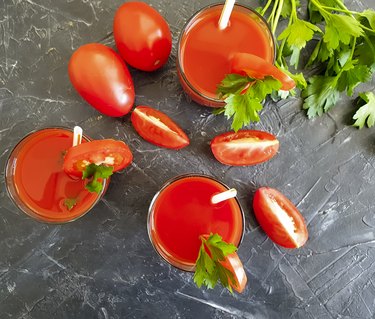
Everyone needs a daily dose of iron, a mineral that's an essential component of hemoglobin and plays a role in the growth of your body and brain. Drinks with iron, as well as iron-rich foods, can help with meeting your daily needs.
Tip
Drinks with iron in them include tomato juice and a vegetable juice blend that contains spinach, which is an iron-rich food.
Video of the Day
Daily Iron Needs
If you're a woman between the ages of 19 and 50, you need at least 18 milligrams of iron a day, according to the National Institutes of Health (NIH). Women older than 50, as well as men, need 8 milligrams of iron a day. However, the average woman only gets between 12.6 and 13.5 milligrams of iron per day, while the average man gets between 16.3 and 18.2 milligrams a day from food.
Video of the Day
If you regularly don't get enough iron in your daily diet or through taking supplements, you're at risk of developing iron-deficiency anemia. While mild or moderate anemia might not cause any symptoms, says the National Heart, Lung, and Blood Institute, severe iron-deficiency anemia can cause fatigue, shortness of breath and chest pain.
Read more: Can Low Iron Levels Kill You?
Drinks With Iron
If you want to increase your iron intake, try making a vegetable juice blend that contains iron-rich foods such as spinach. However, keep in mind that even drinks with iron in don't usually contain a significant amount of the mineral.
For example, one serving, or 15 fluid ounces, of Daily Greens vegetable juice from Bolthouse Farms contains 1 milligram of iron. The beverage is a blend of fruit and vegetable juices, including spinach puree. According to the USDA, 100 grams of raw spinach contains about 2.7 milligrams of iron. Tomato juice also has a small amount of iron — about 1 milligram per 1-cup serving, according to the USDA.
If you need to increase iron consumption in your child, 100 grams of Pediasure contains 1.32 milligrams of iron, the USDA says. Breast milk can also provide iron to an infant, notes the Centers for Disease Control and Prevention, but babies typically need an additional source of iron by about 4 months of age. If your baby is formula-fed, choose one that's fortified with iron, which contains enough to support the infant's needs.
Read more: Types of Iron Supplements
Iron-Rich Foods List
To get more iron in your diet, it might be a better idea to increase your consumption of iron-rich foods. The human body better absorbs heme iron, which comes from meat products. Plant products, such as vegetable juices, contain non-heme iron — which is still beneficial, but not as easily absorbed by your body. Consuming enough vitamin C can also improve how well your body absorbs iron, says Harvard Health Publishing.
The best source of non-heme iron is fortified breakfast cereal, which has 18 milligrams per serving, according to the NIH. Fortified means that iron has been added to the cereal, rather than occurring naturally.
The highest source of naturally occurring iron in food is cooked oysters, which have 8 milligrams per 3-ounce serving, and white beans, which have 8 milligrams per 1-cup serving. Other sources on your iron-rich foods list should be beef liver, dark chocolate, lentils and tofu.
Read more: The 7 Healthiest Iron-Rich Foods to Add to Your Diet
- USDA FoodData Central: "Tomato and Vegetable Juice, Low Sodium"
- National Institutes of Health: "Iron"
- USDA FoodData Central: "Child Formula, Abbott Nutrition, Pediasure, Ready-to-Feed, With Iron and Fiber"
- Centers for Disease Control and Prevention: "Iron"
- National Heart, Lung, and Blood Institute: "Iron-Deficiency Anemia"
- Bolthouse Farms: "Daily Greens"
- USDA FoodData Central: "Spinach, Raw"
- Harvard Health Publishing: "A Healthy Diet Is the Key to Getting the Iron You Need"